Regioselectivity Study guides, Class notes & Summaries
Looking for the best study guides, study notes and summaries about Regioselectivity? On this page you'll find 30 study documents about Regioselectivity.
All 30 results
Sort by
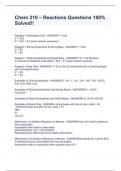
-
Chem 210 – Reactions Questions 100% Solved!!
- Exam (elaborations) • 6 pages • 2024
-
Available in package deal
-
- $11.99
- + learn more
Reagent = Nucleophile Only - ANSWER1° = Sn2 2° = Sn2 3° = Sn1 + E1 (polar medium necessary) Reagent = Strong Nucleophile & Strong Base - ANSWER1° = Sn2 2° = E2 3° = E2 Reagent = Weak Nucleophile and Weak Base - ANSWER1°/2° = No Reaction 3°/resonance stabilized carbocation = Sn1 + E1 (polar medium necessry Reagent = Base Only - ANSWER1° = E2 or Sn2 (if unhindered and no beta-hydrogen with unhindered base) 2° = E2 3° = E2 Examples of Only Nucleophiles - ANSWERCl⁻, ...
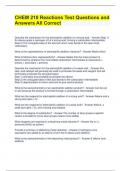
-
CHEM 210 Reactions Test Questions and Answers All Correct
- Exam (elaborations) • 3 pages • 2024
-
Available in package deal
-
- $12.99
- + learn more
CHEM 210 Reactions Test Questions and Answers All Correct Describe the mechanism for the electrophilic addition of a strong acid. - Answer-Step 1) An alkene grabs a hydrogen off of a strong acid, forming a carbocation intermediate. Step 2) The conjugate base of the acid (an anion now) bonds to the open shell carbocation What is the regioselectivity of electrophilic addition reactions? - Answer-Markovnikov What is Markovnikov regioselectivity? - Answer-States that the major product is det...
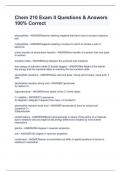
-
Chem 210 Exam II Questions & Answers 100% Correct
- Exam (elaborations) • 4 pages • 2024
-
Available in package deal
-
- $11.49
- + learn more
electrophiles - ANSWERelectron seeking reagents that have room to accept a electron pair nucleophiles - ANSWERreagents seeking a nucleus to which to donate a pair of electrons proton transfer or protonation reaction - ANSWERthe transfer of a proton from one base to another transition state - ANSWERlying between the products and reactants free energy of activation (delta G double dagger) - ANSWERthe height of the barrier, the energy that the reactants attain in reaching the the transi...
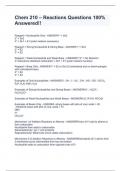
-
Chem 210 – Reactions Questions 100% Answered!!
- Exam (elaborations) • 6 pages • 2024
-
Available in package deal
-
- $10.99
- + learn more
Chem 210 – Reactions Questions 100% Answered!! Reagent = Nucleophile Only - ANSWER1° = Sn2 2° = Sn2 3° = Sn1 + E1 (polar medium necessary) Reagent = Strong Nucleophile & Strong Base - ANSWER1° = Sn2 2° = E2 3° = E2 Reagent = Weak Nucleophile and Weak Base - ANSWER1°/2° = No Reaction 3°/resonance stabilized carbocation = Sn1 + E1 (polar medium necessry Reagent = Base Only - ANSWER1° = E2 or Sn2 (if unhindered and no beta-hydrogen with unhindered base) 2° = E2 3° = E...
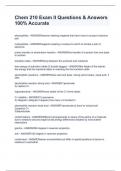
-
Chem 210 Exam II Questions & Answers 100% Accurate
- Exam (elaborations) • 4 pages • 2024
-
Available in package deal
-
- $9.99
- + learn more
Chem 210 Exam II Questions & Answers 10electrophiles - ANSWERelectron seeking reagents that have room to accept a electron pair nucleophiles - ANSWERreagents seeking a nucleus to which to donate a pair of electrons proton transfer or protonation reaction - ANSWERthe transfer of a proton from one base to another transition state - ANSWERlying between the products and reactants free energy of activation (delta G double dagger) - ANSWERthe height of the barrier, the energy that the reac...
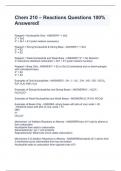
-
Chem 210 – Reactions Questions 100% Answered!
- Exam (elaborations) • 6 pages • 2024
- Available in package deal
-
- $13.99
- + learn more
Reagent = Nucleophile Only - ANSWER1° = Sn2 2° = Sn2 3° = Sn1 + E1 (polar medium necessary) Reagent = Strong Nucleophile & Strong Base - ANSWER1° = Sn2 2° = E2 3° = E2 Reagent = Weak Nucleophile and Weak Base - ANSWER1°/2° = No Reaction 3°/resonance stabilized carbocation = Sn1 + E1 (polar medium necessry Reagent = Base Only - ANSWER1° = E2 or Sn2 (if unhindered and no beta-hydrogen with unhindered base) 2° = E2 3° = E2 Examples of Only Nucleophiles - ANSWERCl⁻, ...
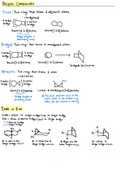
-
CHEM 215 Exam 3 Study Guide
- Summary • 10 pages • 2022
- Available in package deal
-
- $3.99
- 1x sold
- + learn more
This study guide will help you get an A on Exam 3 in CHEM 215 :) It is a summary of Exam 3 content containing colorful diagrams, drawings, and mechanisms. This study guide paired with practice problems will help any student succeed in this course. The study guide contains information from Exam 3 including: -The different types of bicyclic compounds -Endo vs exo -Diels-Alder regioselectivity and stereospecificity -Extended topics in Diels-Alder (heteroatom, inverse electron demand, intram...
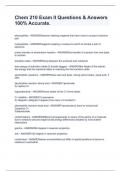
-
Chem 210 Exam II Questions & Answers 100% Accurate.
- Exam (elaborations) • 4 pages • 2024
- Available in package deal
-
- $14.99
- + learn more
electrophiles - ANSWERelectron seeking reagents that have room to accept a electron pair nucleophiles - ANSWERreagents seeking a nucleus to which to donate a pair of electrons proton transfer or protonation reaction - ANSWERthe transfer of a proton from one base to another transition state - ANSWERlying between the products and reactants free energy of activation (delta G double dagger) - ANSWERthe height of the barrier, the energy that the reactants attain in reaching the the transi...
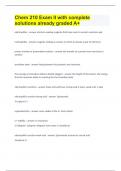
-
Chem 210 Exam II with complete solutions already graded A+
- Exam (elaborations) • 6 pages • 2023
-
Available in package deal
-
- $13.99
- + learn more
electrophiles electron seeking reagents that have room to accept a electron pair nucleophiles reagents seeking a nucleus to which to donate a pair of electrons proton transfer or protonation reaction the transfer of a proton from one base to another transition state lying between the products and reactants free energy of activation (delta G double dagger) the height of the barrier, the energy that the reactants attain in reaching the the transition state e...
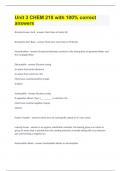
-
Unit 3 :CHEM 210 with 100% correct answers
- Exam (elaborations) • 4 pages • 2023
-
Available in package deal
-
- $13.99
- + learn more
Bronsted-Lowry Acid Must Have a Proton (H) Bronsted-Lowry Base Must have Lone Pairs or Pi Bonds Neutralization Strong Acid donates a proton to the Strong Base to generate Water and the Conjugate Base Electrophile Electron Loving An atom that wants electrons. An atom that is electron rich. Must have a partial positive charge. (Cation) Nucleophile Nucleus Loving If opposites attract, then a _________ is electron rich. Must have a partial negative charge. (An...



